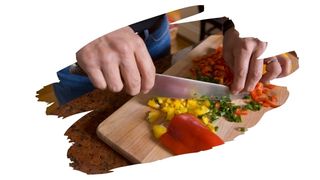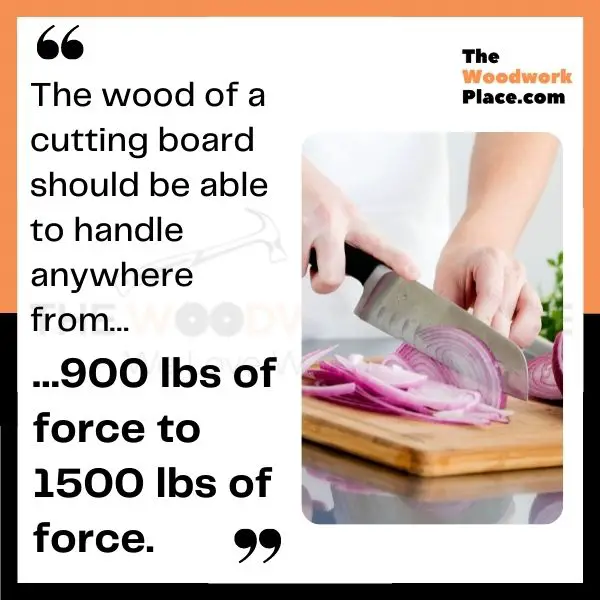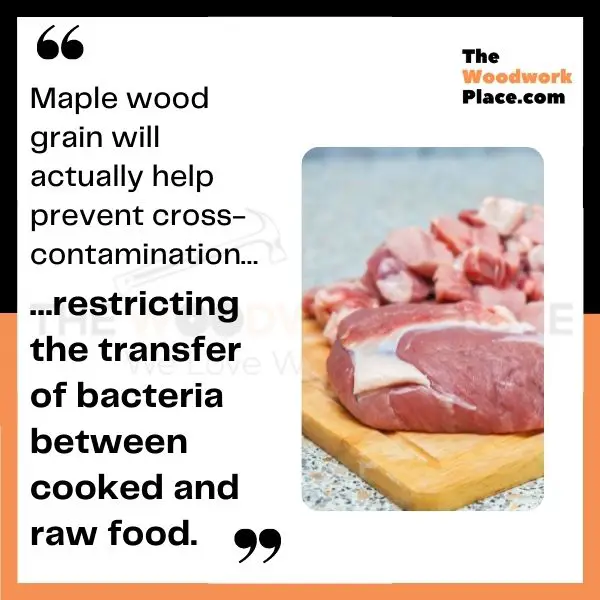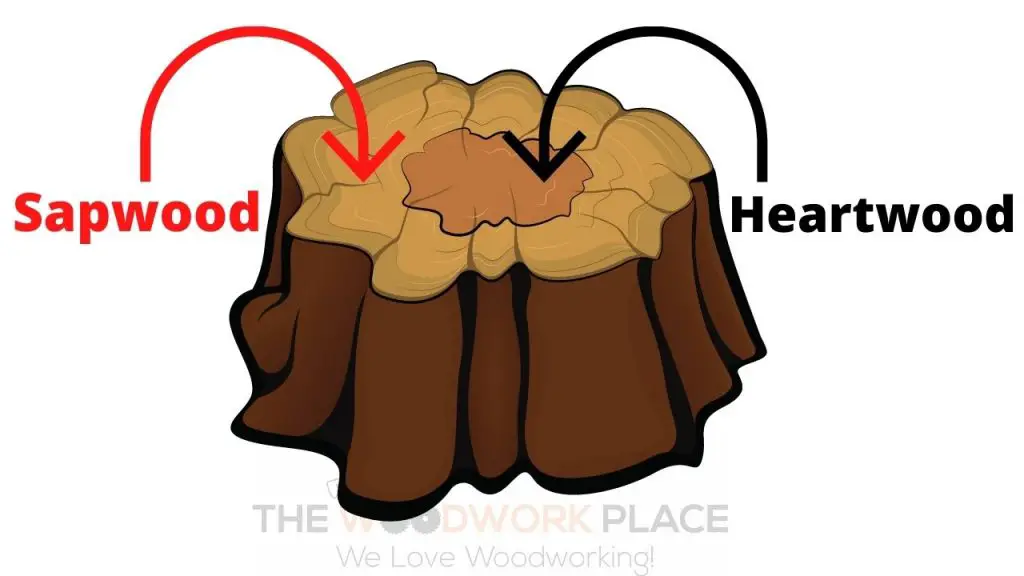The exact type of wood you choose can make or break your cutting board… or your kitchen cutlery!
But, when it comes to the world of cutting boards, there are two specific hardwoods that seem to get recommended time and again; Hard Maple and Cherry Wood.
These two tough straight-grained wood types are widely used to make everything from furniture to flooring.
But, can they also be used for the cutting board on your kitchen countertop?
Well, in this post, you are going to learn what really separates cherry from maple (and why it matters for your chopping block). We also dive into why having a cutting board that is too hard can be a problem.
Plus, we reveal which one of these cutting board timber types is not just food safe, but also antibacterial…

This post may contain affiliate links to products that we receive a commission for (at no additional cost to you). Learn more here.
What Is The Best Cutting Board Material?
Cutting boards need to be made from material that is hard enough to endure mighty chops. However, that material still needs to be ‘soft’ enough to not dull the sharp edge of your kitchen tools.
That is why solid materials that have a little give, (enough to absorb those sharp metal edges), are ideal. So cutting boards tend to be made from stuff such as wood, plastic, bamboo and rubber.
Related Post: Edge Grain vs Face Grain Cutting Boards (Which Is Which?)
What’s The Best Wood To Use For A Cutting Board?
When it comes to wooden chopping boards, you need to find wood that’s of just the right density. In short, you need wood that is hard, but not too hard.
But that’s a little vague. To figure out just how hard cutting board wood should be, we need to refer to something called the Janka Scale.
The Janka Scale (And Why It Matters For Your Cutting Board)
The durability of wood is measured by using a Janka Rating. The Janka rating, measures how much force it takes for a small steel ball to make a dent in a piece of wood.
The more pounds of force it takes to make that dent, the higher that wood’s Janka rating will be.
Now, when it comes to cutting boards, the optimal Janka rating range for lumber is between 900 and 1500. That means the wood of the cutting board should be able to handle anywhere from 900 lbs of force to 1500 lbs of force.
Anything lower than 900 lbs of force, and that wood is simply too soft. You’ll end up chopping right through it.
Any higher than 1500 lbs of force, and your cutting board is going to be so tough that it will damage your kitchen cutlery.

Cherry Vs Maple Janka Ratings
Maple wood’s Janka rating lies just within touching distant of the high end, with a Janka rating of 1450 lbs of force.
While American Cherry wood sits just above the very bottom end of the range, with a Janka hardness rating of 950 lbs of force.
Related Post: Is Sycamore Good Enough For Cutting Boards? (Solved!)
They’re Both Within Range. What Difference (If Any) Is There Between A Maple And Cherry Wood Cutting Board?
Janka rating aside, there is more to consider when it comes to choosing a timber type for your chopping board.
You see, while a hardwearing lumber will make your cutting board more durable, it is no measure of how safe it is to use that wood as a food prep surface.
So, lets take a look at the 3 key things you need to consider when comparing Maple against Cherry wood; Durability, Price, and most importantly, Food Safety.
Comparison 1: Cherry vs Maple Wood for Durability
Is Maple Hard Enough For A Cutting Board?
With a 1450 Janka rating, Maple can – and will – easily handle the daily chop.
But, (and this is a big but), hard maple has a reputation of dulling saws and router bits (as it can be so tough to cut). Plus, Maples natural toughness makes this wood type difficult to work with too.
Regardless, Maple easily beats out Cherry wood when it comes to taking on impact shocks.
Isn’t Cherry Wood A Bit Too Soft For A Cutting Board?
To be honest, Cherry wood is much, much softer than Maple wood.
Sure, it is still plenty tough enough to handle the shock impact of being a cutting board lumber. And it’s softness makes this timber super easy to work with. You can even carve and whittle Cherry wood too.
Related Post: Is Cherry Wood Good For Carving? (Solved!)
But, Cherry’s big advantage over Maple is the fact that Cherry won’t blunt the cutting edge of your kitchen utensils.
Who Wins Based On Durability? It’s A Draw.
And here’s why: Maple Wood will be better for your cutting boards durability, but Cherry Wood will be more forgiving on your kitchen cutlery.
Related Post: Acacia Vs Maple Cutting Boards (4 Key Pros And Cons)
Comparison 2: Cherry vs Maple Wood for Price
Just How Expensive Is Cherry Wood Really?
Cherry wood is fairly expensive, certainly more so than Maple wood. That is because the heartwood of this tree is very durable, due to its high resistant to rot and decay. Making Cherry a top-end lumber.
But, Isn’t Maple Wood Expensive Too?
Far from it. For a hardwood, Maple is a fairly inexpensive and sustainable lumber. Making it an affordable alternative wood, (compared to Cherry), for furniture.
Who Wins Based On Price? Maple Wins
And here’s why: Maple wood is much more budget-friendly than Cherry – costing less by the board.

Comparison 3: Cherry vs Maple Wood for Food Safety
Is Cherry Wood Food Safe?
Well, you shouldn’t consume raw cherry wood, obviously. However, once coated with a food grade wood finish, cherry wood is safe as a surface for food preparation.
However, it will still always need to be coated in a food-safe wood finish. And for cutting boards, a 100% food grade mineral oil is an ideal finish.
Related Post: Walrus Oil Vs Mineral Oil: Which One’s Better For Your Cutting Board?
Does Cherry Wood Rot?
While the popular fruit of this tree will go off, it’s lumber will be fine for a good long while. That is because the incredibly dense heartwood of this tree resists rot incredibly well.

And Are Maple Cutting Boards Sanitary?
Maple is a bit of a special case in this regard, because it’s fine wood grain actually trap bacteria.
Wait… Is Maple Wood Really Antibacterial?
Well, the shape of Maple’s wood pores, (or vessels), actively draws in juices, liquids, and the like.
Not only that, the shape of these vessels works like a trap, keeping bacteria inside it’s wood grain. And, more importantly, not letting those microorganisms drift back up to the surface to contaminate food.
What’s more, after you wash and rinse the cutting board, all of that bacteria gets washed away easily too.
Who Wins Based On Food Safety? Maple Wins
And here’s why: Maple wood will actually help prevent cross-contamination, restricting the transfer of bacteria between cooked and raw food.
To Sum Up, Is Maple Or Cherry Better For Cutting Boards?
When it comes to making cutting boards, Maple wood is pretty much your number 1 go-to timber choice.
And based on the 3 key areas that matter for a cutting board, Maple easily beats out Cherry wood.



